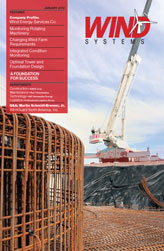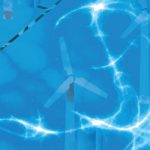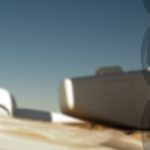The rotating machinery in a wind turbine has demanding requirements. Consider that designing a wind turbine gearbox is equivalent to designing an automotive gearbox to last for two million miles, with 15 times as many cycles. The machine must be light and thereby flexible, and it is subject to transient loads and overload, idling conditions, and temperature extremes. Service of this long duty cycle machinery must be performed 80-odd meters from the ground.
Fortunately, various offline and online monitoring technologies help to keep an eye on the health of your machinery—vibration, temperature, and lubricant condition, for example. The technology is generally well established yet the application of monitoring is still challenging, and no all-encompassing gadget or approach is going to warn you of every machinery failure. Tuning monitoring equipment, or your approach to problems reoccurring in your wind farm and machinery, is generally a good step to take.
Common Problems
A few examples of common problems the industry is facing today include:
Type 1: Inclusions in gear material, from poor quality control on the raw material manufacturing. The inclusion acts as a stress concentration and can result in tooth fatigue failures, often readily identifiable from visual inspection due to characteristic beach marks radiating out from the crack origin.
Type 2: Gear surface tempering (grinding burn), where the surface temperature of the case hardened gear has not been controlled properly during grinding. This can even lead to re-austenization and re-hardening of the material. Temper grinding burn will reduce the surface hardness and residual stress condition, which will reduce wear resistance. Re-hardening burn will produce a hard, brittle surface layer, and cracks may begin in the tooth surface and result in low life for pitting and fracture.
Type 3: Axial cracking in through hardened bearings, where the bearings are prone to cracking as they have inherent poor toughness and residual tensile stresses due to the heat treatment process (compared to case carburized bearings). They may suffer from hydrogen embrittlement, have superimposed hoop stresses from inner ring raceway fits, and they are often subject to harsh overload conditions in the wind turbine. The cracks may lead to the raceway slipping on the shaft, and potentially a catastrophic failure in the gearbox. Any cracks will also form a nucleation point for surface rolling contact fatigue, where the raceway surfaces will break up due to fatigue spalling.
Type 4: Poor load sharing conditions in double row spherical roller mainshaft bearings, where the downwind raceway of the bearing supports all the thrust loading from the blades, while the upwind raceway becomes unloaded. The operating condition is poor (i.e. the axial to radial load ratio on the downwind race is too high), and the bearing tends to suffer from adhesive wear and micropitting toward the roller ends due to roller skewing under the extreme load conditions. The generated debris then contaminates the grease, causing surface indentations on rollers and raceways, and eventually leading to a runaway surface fatigue failure.
These four examples are machinery problems that, if they happen two or so times in your fleet of 100 turbines, you can reasonably expect them to happen again. A Weibull analysis using the failure records will provide estimates of future failures with a statistical basis and indicate whether the failures are due to infant mortality, aging, or from some random external influence. Getting a grip on how to detect the problem consistently and plan your maintenance and repair in advance, as well as avoiding secondary damage or catastrophic failure, will bring a good payback.
Detecting Defects
Temperature trending is easy to do. Every modern turbine SCADA system records 10-minute temperature data for the gearbox oil and several bearings, mainshaft bearings, generator bearings, and various other locations such as pitch motor temperatures and generator winding temperatures. Temperature can provide a good indication of a problem (see Figure 1), which provides the distribution of temperature each week. The bearing showed a clear trend of overheating; the replacement was scheduled two months out when mean temperatures approached 75°C and the damage was approaching a critical stage (Figure 2).
Yet not all damage is obvious, or the trend slow. For example, if inclusions are present in the gear material the fatigue crack origin is likely to be subsurface, and cracking may propagate along the tooth axially some distance before reaching the surface, at which point a large tooth segment may be quickly liberated. This is a catastrophic failure that requires immediate shut down. Detecting such damage should not be difficult. The RMS (root mean square value of the vibration level) will increase rapidly, and the envelope spectra (a demodulated vibration signal) will show an obvious issue. Figure 3 provides an easy “spot the difference” example.
An axial crack forming in a wind turbine bearing raceway is actually similar to the type of controlled experiment performed in research laboratories, where a raceway or roller has a line defect machined for production of a clear repetitive impulse. The crack will cause a sharp impulse when it passes through the bearing contact zone, exciting the structural system in a similar fashion to a modal test. The impulse will excite natural frequencies of the structure that are detected at the various vibration sensor locations, depending on the transfer function between impulse location and sensor. The natural frequencies become a carrier frequency, and when the envelope analysis technique is applied the signal is demodulated to provide the frequency of the defect. Figure 4 shows the frequency spectra for a bearing that has developed such a crack and the marked change in the frequency spectra.
Defects on inner raceway, outer raceway and rollers occur at different frequencies. For stationary outer raceway, an inner raceway defect is manifested by roller pass frequencies (RPFI) modulated with shaft frequencies (ωs) as the crack rotates through the contact zone. The outer raceway defect frequency (RPFO) has no modulation for a fixed outer raceway. The roller defect frequency (2RSF) is twice the roller spin frequency as the defect hits the inner and outer raceway once per roller revolution and is modulated by the cage frequency (ωc). These defect frequencies commonly include higher harmonics. Table 1 provides a summary for a fixed outer raceway.
Avoiding Failure
Many installed condition monitoring systems (CMS) are configured with certain envelope analysis parameters, yet they don’t necessarily band pass the appropriate carrier frequency to detect the crack. Figure 5 illustrates this, with the RMS of a standard envelope (and RMS) from installed CMS compared to an envelope technique customized by Romax to find cracks occurring at this particular wind farm. In this case temperature data also showed no evidence of the crack formation and growth.
Main bearings failing from micropitting and surface fatigue are another challenge. Here the rotational speeds are very slow, and the bearing fault frequencies are falling in the range of 1-5Hz. The machine has speed and load variations within the same frequency range which brings some challenges. When the shaft speed varies the machine frequencies vary with time, which smears the spectrum. In order to compensate for the speed fluctuations, the shaft speed is used to re-sample the vibration signal.
Nonetheless, a combination of techniques allows the detection of the bearing failure, which for this common failure mode can be six to nine months in development from initial damage to a critical state. Figure 6, Figure 7, Figure 8 provide temperature and vibration examples for a group of the turbines (note that the days on the graphs correspond). Here several bearings at the site are failing, yet temperature trends are only clear in one machine, where the damage is severe. A combination of several vibration techniques including customized envelopes and trending fault frequencies as well as certain envelope bands does yield good results. Once a certain level of damage is reached, the bearing defect trends can decrease (Figure 7). This is a sign that the damage has progressed from isolated areas to a large proportion of the raceways and rollers, as was the case when the bearing was inspected at day 0. The customized envelope is providing a much earlier and clearer indication of damage, and the temperature trend only provides a late indication. See Figure 8 for an image of the condition of the main bearing for Turbine A at -128 days, and Figure 9 during teardown inspection by Romax engineers.
Understanding the root causes of failures and not having surprise problems that stop or reduce production at your wind farm reduces O&M costs. When failures occur, perform root cause analysis with experienced inspection engineers, gear and bearing designers/analysts, and metallurgists. Use the turbine data that is available, whether SCADA/vibration or both, and develop approaches that work well for the failures that occurring commonly. Conduct an annual vibration data acquisition and assessment campaign if CMS is not installed and is too costly. Apply reliability statistical methods to predict component lifetimes, and if poor consider re-engineering or other mediation to extend service life.
Conclusion
Romax Technology is a global engineering consultancy providing services to the wind industry. We have designed certified gearboxes for nine different turbine manufacturers and provide services to wind farm owner/operators including machinery inspection, SCADA assessment, vibration analysis, root cause analysis, and problem solving. Romax has U.S. offices in Boulder, Colorado, and Troy, Michigan.







































